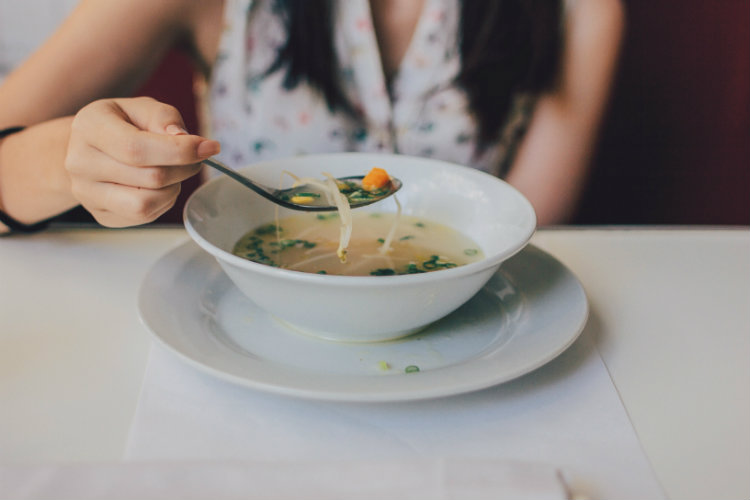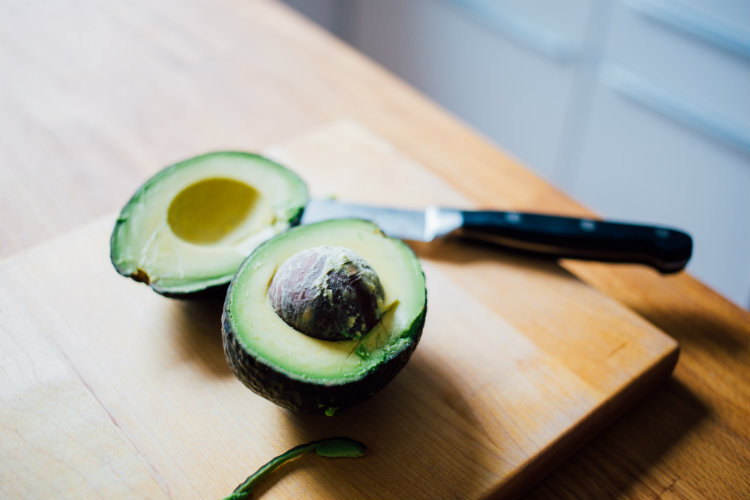Irish Essayist | Jam on Toast
A form of literary autobiography, the personal essay allows us to ruminate on truths from our own life experiences. Every Wednesday this month, the Irish Essayist series will see writers test the continually-expanding essay format to explore subjects as diverse as mental illness, gender, music, growing up, and more.
Jam on Toast
by Amy Clarkin
If you ever see me in my favourite coffee shop, you will always see the same sight. A woman in her late twenties, pale, with berry stained lips and kohl rimmed eyes. If it’s the weekend I will be chatting animatedly with my best friend, fulfilling our ritual of sharing the tales from our weeks over warming coffees, our whispers merging with the steam wafting from the drinks before us. If I am alone, my eyes will be trained on whatever book I’m reading at that moment, a pen in hand and a notebook beside me. Without fail, the same order will be in front of me. A blue cup filled with dark, aromatic coffee, and a plate topped with slices of perfectly toasted bread accompanied by a ceramic pot of homemade jam. This coffee shop does amazing food, and it must seem odd that I never order one of their generous egg dishes or decadent pancakes, sticking instead to an order that seems so plain, so simple.
It is anything but.
Every slice of toast, perfectly browned, is a victory. Each generous slather of crimson jam, bursting with seeds and carefully spread across the surface, is a hard fought battle. It invokes a memory of an easier time, a nostalgic visit to when food was simply food, something to be enjoyed, not a source of fear, anxiety or concern. Not assigned moral values or societal stigma, viewed solely in terms of caloric quantities and macronutrient values.
I was always self-conscious about my body, but it was when I became ill that my descent into disordered eating began. In 2015 I developed a chronic illness that, among other things, triggered a fatigue so intense that I couldn’t work, socialise regularly, or leave my home for more than a few hours. As doctor after doctor looked pityingly at me, shrugging their shoulders and telling me that they felt sorry for me, but there was nothing that they could do to help, I felt completely helpless, a lost cause. I’d always loved mysteries, but that didn’t mean I wanted to become one.

The usual routes fruitless, I began to explore uncharted waters. That’s when I found them – the wellness warriors, paradigms of health and nutritional virtue, singing a siren song of chronic conditions healed through ‘clean eating’ and ‘unprocessed’ foods. Enchanted, ensnared, I changed course, following their call. Of course, I was headed straight for the rocks.
Wellness promises two things that I desperately craved – hope and control. Everyone is vulnerable to its spell, but as someone with an undiagnosable – and therefore untreatable – fluctuating illness, it was my kryptonite. Wellness assured me that if I just ate a certain way I could be better. Its ambassadors whispered tales of recovery, promises dripping from honeyed (honey being an “acceptable” form of sweetness, of course) lips that if I followed their guidance, their rules, all would be right. I couldn’t control my body, or my symptoms, but I could control what I ate. Isolated, lonely and desperate, I grabbed at what I thought was a lifebuoy. It was an anchor that would drag me to the darkest depths.
I hid behind a shield of ‘health’ constructed from a nutrition plan that allowed me to justify further limiting my diet (already restricted by a stomach condition). I surrounded myself in an air of virtue, after all, who could judge me for being too healthy? I would sip black coffee while my friends had pancakes at brunch, make excuses not to go out to dinner even if I felt physically able to because it didn’t fit the plan. The thought of eating something outside of the list of permitted foods filled me with such anxiety that I would be on the verge of a panic attack. I wouldn’t even drink water until I was assured that it was filtered, so terrified was I of polluting my body, completely oblivious to the fact that my mind was being slowly poisoned itself.
Orthorexic thinking merged with anorexic tendencies, and I locked myself in a world of fear, where food was something to be suspicious of, monitored, measured – not a source of pleasure, comfort or social interaction. “Refined” sugar became the devil as I blissfully ignored the fact that it has the same chemical reaction in your body as processed sugar and I hid a fear of carbohydrates behind the fortress of the nutrition plan. I justified further food eliminations by comparing them to the FODMAP diet I follow for IBS, despite the fact that that was assigned by a registered dietician based on evidence based research, not the whimsical promises of an Instagram nymph brandishing bowls of ‘superfoods’ and ‘courgetti’. My fatigue got worse, my anxiety heightened, yet I clung to the strict food rules, convinced that if I deviated it would make me worse. I was lost in a forest, with no idea how to find my way back to the path, blind to the fact that I had strayed from it at all.

The rules were rigid. Weigh everything. Count everything. Log everything. The world condensed to a notebook filled with numbers, quantities, the fear seeping off the page, inky lists filling its pages with tear streaked smudges of fear. Check your body any time you pass a mirror, scrutinising it for the miniscule changes you are sure you can detect. Retreat from any scenario where your control will be challenged. Hide in your cave, crouched in the darkness, staring at the shadows you believe will set you free. Close your mind to the irony that you are doing this to heal yourself, so that you can live your life again, even if it makes you avoid the few ‘normal’ things that you can do.
“It’s not fair” I sobbed to my therapist after I finally accepted that my relationship with food was far from healthy. ‘I’m not even thin.’ So warped was my vision that, in my head, only thin people could have eating disorders. It seemed unfair that, facing a long uphill battle with body image and food fear, I didn’t even ‘get to’ be thin. I was walking a tightrope, trying to balance a fear of eating the ‘wrong’ foods with a fear of gaining weight and it was about to snap, sending me plummeting into the canyon below. I could control my food intake, but not how my body reacted to it. It was devastating, and perversely made me cling all the tighter to the warped food rules I adhered to, convinced any deviation would make things worse.
The wellness industry often feeds you the idea that you are solely responsible for your health through what you eat – it is a treacherous hole for a chronically ill person to fall into. Assigning moral values to foods can be dangerous for anyone, and it is the desperate who cling to it the most. Hope and control are the two things that we search for, that we crave desperately. The further into the labyrinth we wander, the harder it is to find our way back out. There is no thread-lined path to guide us back.
Eating disorders suck the joy out of life. Meals, especially meals out become a source of fear, sucking the pleasure out of actually getting to see people with a plethora of anxieties surrounding the menu. Eating healthily is something that is important and is enjoyable – but when it controls your life to the extent that you are paralysed with fear at any deviation, it is no longer an asset. Balance and moderation, two words that seem dull, are key. When your life has no room for spontaneity, for small indulgences, there is a problem. An ice cream on a warm day, the sticky sweetness of icing on a delicately decorated cake, the warm cheese stretching on top of a stone baked pizza, a bar of creamy chocolate on a cold night curled by the fire; they are as important to our wellbeing as kale and fruit. Food weaves a tapestry of reminiscences, of sensations, a nostalgic reminder capable of transporting us into our memories. It knits a pattern of our lives, joining the dots from events to occasions – Easter eggs, eagerly cracked open, the smell of rich chocolate rising to greet us. Crisp apples in autumn, their juices running down our throats. Birthday cakes, topped with candles to celebrate the passing of another year, the flames reflecting joyful faces. Mulled wine sipped in cosy snugs by candlelight in the winter and fresh lemonade swigged while basking in the sunshine in the summer, the perfect mix of sweet and sour. It is a uniting factor, a way of celebrating and a source of comfort, a shared experience. One of our five senses, taste allows us to experience aspects of life in it’s own unique way. Deprived of it, the world around us dulls, our sensations limited in its deficiency.

Eight months into recovery and it has been a rocky path. For every step forward there is a relapse. Every flare of my illness triggers disordered thoughts, a dread that I have brought this on myself. Separating the foods I genuinely cannot eat from those I fear to eat is a battle. Finding pleasure in food is still a rare treat.
Jam on toast is a symbol of how hard I’ve fought, a trophy of progress. One year ago I could never have eaten it. There’s no protein! It has refined sugar! It’s processed carbohydrates!
It’s also delicious.
Jam on toast is pure comfort, a nostalgic delight from childhood. It also represents everything I fight for in my head on a daily basis. As I take a bite, savouring the crunch of the warm bread mixed with the sweetness of the jam, taste buds tingling, it is a reminder that this battle can be won. It’s a long, tough journey, filled with setbacks, mountains to climb, pits to traverse. It might lack the illusion of control, over my body and my illness, that I so desperately crave, but it is a desire for something else. It whispers promises of shared meals with friends, of cooking delicious dishes to share with my family, of finding the joy in food again. More than anything, it tastes like hope.

